This article is sponsored by Verizon Media.
We are living in a world few saw coming as recently as six months ago. In a climate where making long-term predictions is all but impossible, even the savviest marketers are being forced to rethink their media strategies around ever-changing consumer behaviors. With more to lose – and fewer resources to risk – the wrong marketing strategy and media investments can have lasting effects for a brand.
Until recently, advertisers have relied heavily on linear TV and social media to reach large, highly engaged audiences. Today’s world has impacted these go-to advertiser channels for myriad reasons: disruption to high valued broadcast programming, polarizing news cycles, and new focus on racial and social injustices that’s forced brands to rethink the impact of where they spend their media dollars. To navigate this new landscape, brands must look for new options that offer control, flexibility and scale, and CTV offers just that.
The TV tides are turning
Once a cornerstone of media planning, seasonal and live events programming has been canceled this year across sports leagues and awards programs. For the handful of event producers that are moving forward by fielding teams in closed sports stadiums and the like, audience tune-in is unpredictable at best. Coupled with the halted production of new, original entertainment content, networks are facing an unprecedented lack of “anchor programming.”
Advertisers are pivoting accordingly. According to eMarketer, US upfront TV ad spending is on the precipice of an enormous decline. Spending was already down 1.4% for the 2019-2020 TV season, but expectations are that the 2020-21 season will experience a 27.1% drop, down to $14.78 billion. That represents a staggering $5.5 billion difference year on year.
Even before the pandemic, consumer adoption of streaming video had begun to accelerate, to the detriment of traditional cable packages. The number of pay-TV households peaked in 2010 at 105 million; now it’s down to approximately 82.9 million. A study last year by eMarketer forecast that number to dip to 72.7 million by 2023.
And digital video is on the rise. Users will spend 10 more minutes per day on mobile video apps this year, second only to time spent on social media. Overall, the average American adult will watch more than two hours of digital video daily in 2020.
Murky waters for social media
We’re seeing an unprecedented shift in consumer and brand relationships. In a recent study by Dynata, 62% of respondents between 18 and 35 years old said they will be “doing more research on brands and their inclusivity practices before purchasing, in light of recent events.” A brand’s values are now as important if not more than their products in the eyes (and wallets) of their audience, placing extra importance on brand safety in digital media spaces.
Brands are pushing back more forcibly against online misinformation, conspiracy theories and divisive rhetoric than they have previously done. And no wonder: Consumer trust in social platforms is at an all-time low.
Advertisers are well aware of the risks that come with appearing adjacent to unsafe content. In the first 10 days of July, Facebook’s top advertisers spent 19% less on the social network compared to the same period in 2019, according to Pathmatics. Meanwhile, the top advertisers on Twitter decreased spending by 9% compared to the same period in 2019.
Steering toward streaming
To survive and thrive in these volatile times, successful brands must evolve in real time alongside their consumers, the economy and technology. The good news is that consumer appetite for entertainment is at an all-time high. Connected TV (CTV) and other digital streaming services are experiencing a 60% growth in consumption, according to Verizon Media internal data. This gives brands new ways to reach guaranteed, high value audiences at scale. CTV brings the seamless planning, precise audience targeting and advanced measurement capabilities of programmatic to TV campaigns, allowing marketers to activate campaigns quickly and provide nimble optimization capabilities. That’s especially important as we approach an upfront season like no other.
The key to success in 2020 and beyond for marketers is the ability to shift budgets where audience engagement is blossoming now, not where it has done historically.
With an increase in video and CTV supply and decline in CPMs across digital platforms, the opportunity is huge for advertisers willing to ride the streaming wave and leave TV and social investments in their wake. Programmatic opportunities can help you do so efficiently and effectively.
Learn how to effectively transition into the CTV world your audience is increasingly living with this short video from the Verizon Media Programmatic Partner Series.















